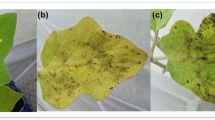Abstract
Populations ofTyphlodromus doreenae Schicha on 18×14 cm arenas using pollen ofTypha orientalis Presl. as food, increased from an estimated 50–150 to 1,000–1,600 motiles per arena in the presence of mould mites,Tyrophagus putrescentiae (Schrank) and the fungusRhizopus stolonifer (Ehrenberg ex. Fr.) Lind.T. putrescentiae in association withR. stolonifer, developed pigmentation and were preyed on byT. doreenae which also became pigmented. UnpigmentedT. putrescentiae were not attacked byT. doreenae which remained pale coloured.T. doreenae died when supplied with the fungus alone. Bean plants dusted with pollen ofT. orientalis from a talcum powder dispenser supported a large population (7–12 stages/leaf) ofAmblyseius victoriensis (Womersley). These improvements to mass rearing ofT. doreenae andA. victoriensis are discussed with respect to their potential for commercialisation.
Similar content being viewed by others
References
Hodgson, R.K., 1976.Tyrophagus putrescentiae (Acarina: Tyroglyphidae) in cultures ofDermatophagoides farinae (Acarina: Pyroglyphidae) controlled by low humidity. J. Med. Entomol., 13:223–224
Hoy, M.A., Castro, D. and Cahn, D., 1982. Two methods for large scale production of pesticide-resistant strains of the spider mite predatorMetaseiulus occidentalis (Nesbitt) (Acarina: Phytoseiidae). Z. Angew. Entomol., 94:1–9.
James, D.G., 1989. Influence of diet on development, survival and oviposition in an Australian phytoseiid,Amblyseius victoriensis (Acari: Phytoseiidae). Exp. Appl. Acarol., 6:1–10.
James, D.G., 1990. Biological control ofTetranychus urticae Koch (Acarina: Tetranychidae) in southern New South Wales peach orchards: the role ofAmblyseius victoriensis (Acarina: Phytoseiidae). Aust. J. Zool., 37:645–655.
James, D.G. and Whitney, J., 1990. Biological control of grapevine mites. Aust. Grapegrower and Winemaker, 321:37–43.
James, D.G. and Whitney, J., 1993. Cumbungi pollen: A laboratory diet forAmblyseius victoriensis andTyphlodromus doreenae (Acari: Phytoseiidae). J. Aust. Entomol. Soc., 32:5–6.
Karg, W. and Mack, S., 1986. The importance and use of oligophagous predatory mites of the cohort Gamasina Leach. Archiv. fur. Phytopath. und Pflanzen., 22:107–118.
Overmeer, W.P.J., 1985. Rearing and Handling. In W.Helle and M.W.Sabelis (Editors), Spider mites, Their Biology, Natural Enemies and Control, Vol. B. Elsevier, Amsterdam, pp 161–160.
Smith, D. and Papacek, D., 1991. Studies of the predatory miteAmblyseius victoriensis (Acarina:Phytoseiidae) in citrus orchards in south-east Queensland: Control ofTegolophus australis andPhyllocoptruta oleivora (Acarina:Eriophyidae), effect of pesticides, alternative host plants and augmentative release. Exp. Appl. Acarol., 12:195–217.
Author information
Authors and Affiliations
Rights and permissions
About this article
Cite this article
James, D.G. Pollen, mould mites and fungi: improvements to mass rearing ofTyphlodromus doreenae andAmblyseius victoriensis . Exp Appl Acarol 17, 271–276 (1993). https://doi.org/10.1007/BF02337276
Accepted:
Issue Date:
DOI: https://doi.org/10.1007/BF02337276




